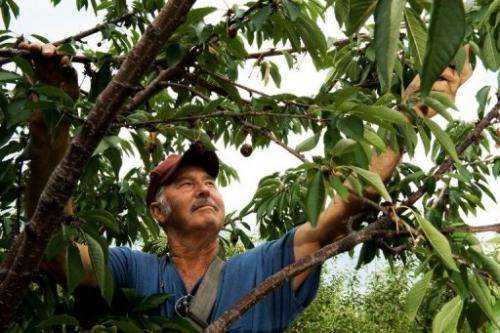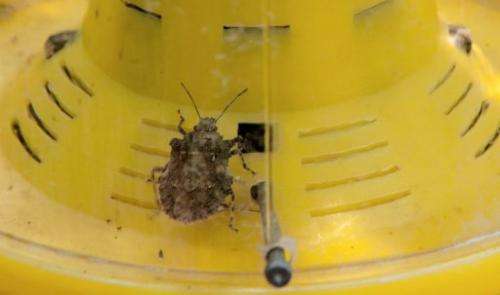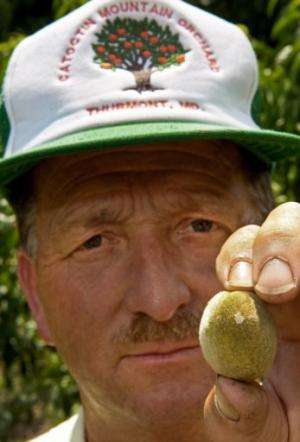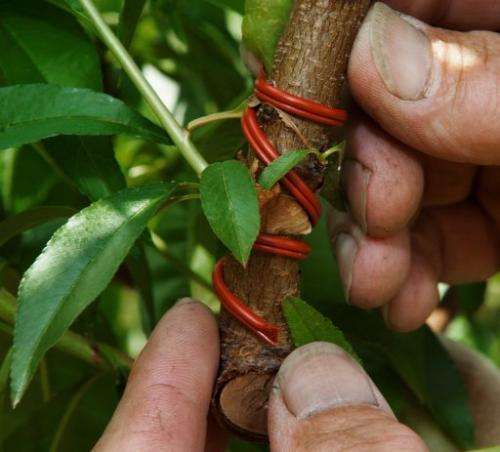Asian 'megapest' is chomping up US orchards

A stink bug from Asia is chomping up US vegetable fields, orchards and vineyards, causing experts to scramble through an arsenal of weapons to try and halt this stealthy, smelly predator.
Pesticides, parasites and traps have all been tried but none have succeeded in killing off the brown marmorated stink bug, Halyomorpha halys, which first surfaced in the northeastern United States in 1996 and has since spread to 33 of the 50 states.
After having tried just about everything, farmer Bob Black said he sometimes resorts to a known weapon -- his fist.
"I smash 'em, I am so mad at 'em," he said. "The thing stinks, it's terrible... they emit this defensive odor system and that is why nothing will eat them."
Black, who runs Catoctin Mountain Orchard in Maryland, saw big damage to his fruit business last year and is trying to avoid more this year by allowing scientists to research the bugs on his land and by spraying more pesticides.
He rarely sees the insects themselves, leading him to believe they may siphon the life out of his fruit at night, like vampires.
"The way they feed with their hypodermic needle mouth is they pierce down into any product, skin or tree up to three-eighths of an inch (one centimeter) and suck the juices out so it becomes a dry area," Black told AFP.
It's hard to put a dollar figure on how much is at stake, or how much has been lost nationwide because the scourge is so new, experts say.
According to Black, some of his crops last year were cut by 15-20 percent. Others, like all of his nectarines, were donated to a food bank because they had stink bug damage -- still edible but with bruises and dry patches. Shoppers only want to pay for perfect fruit, he said.
The stink bug can live off any one of 300 host plants, including grapes, peppers, apples, corn, and tomatoes.

Birds, bats, spiders, and praying mantises will eat them, but the stink bugs are so fertile that they can outbreed any potential villains, according to Tracy Leskey, a research entomologist at the US Department of Agriculture.
"A single female can lay on average about 200-250 eggs in her lifetime," Leskey said. "Some females can lay up to 400 eggs."
The bug likely made its way accidentally into the US in a shipment from Asia, and over the years has experienced a major population boom. Last year, Leskey said one of her small-scale trapping experiments ended up snaring 15 gallons (66 liters) of them.
"We are just learning more about their movement pattern, when they start to invade, and also we are learning more about the better pesticides," said Leskey, who helped create a task force in 2009 of about 100 experts who meet regularly to share their research.
In recent weeks, the bugs that Americans may have seen in their homes taking shelter over the winter have moved outside to breed, and around now their eggs are likely hatching.
Some pesticides that are already on the market can kill the bugs, but the timing has to be just right, and the solutions have to be rotated to avoid creating resistance.

The Environmental Protection Agency said it is considering an emergency appeal to authorize a pesticide called dinotefuran, already approved for vegetables, grapes and cotton, to protect fruit in Virginia.
"EPA recognizes the significant impact of the stink bug on agriculture," a spokeswoman told AFP.
"The agency believes this exemption would be needed approximately by mid-July. EPA will make sure a decision is made before that time frame."
Another trick would be getting just the right parasite in high enough numbers to eat away at the stink bugs. In Asia, a parasitic wasp does the work nicely, but the North American types are only successful in killing a small percentage of them.
A US government lab is cultivating a collection of parasitic wasps from Asia, but it will be several years before they may be unleashed because of the high risks of upsetting the ecosystem further with another invasive creature.
"It is so seldom that we get a pest of this magnitude that affects so many things, that it has really shifted a lot of our research activity," said Doug Pfeiffer, a professor of entomology at Virginia Tech University.

"It is really a megapest compared to our native stink bugs."
And with increasing global trade, the epidemic of invasive insects around the world is only likely to get worse.
"International movement of pests is a two-way street," said Pfeiffer, pointing to the damage done by the Colorado potato beetle in Eastern Europe and a pest called the American white moth that is killing sections of forest in China.
In the United States, the creature is called a fall webworm, and it makes harmless webs on tree branches, but was "introduced into China without the natural enemies that help suppress it here," he said.
For farmer Black, the march of the stink bug has put him on the defensive. He is spraying more pesticide than before, using more costly fuel, and tossing out more fruit, meaning his prices will have to go up.
"This could actually affect the food supply in the whole nation," said Black, 60. "It is the most challenging thing that I have ever had to deal with."
(c) 2011 AFP



















